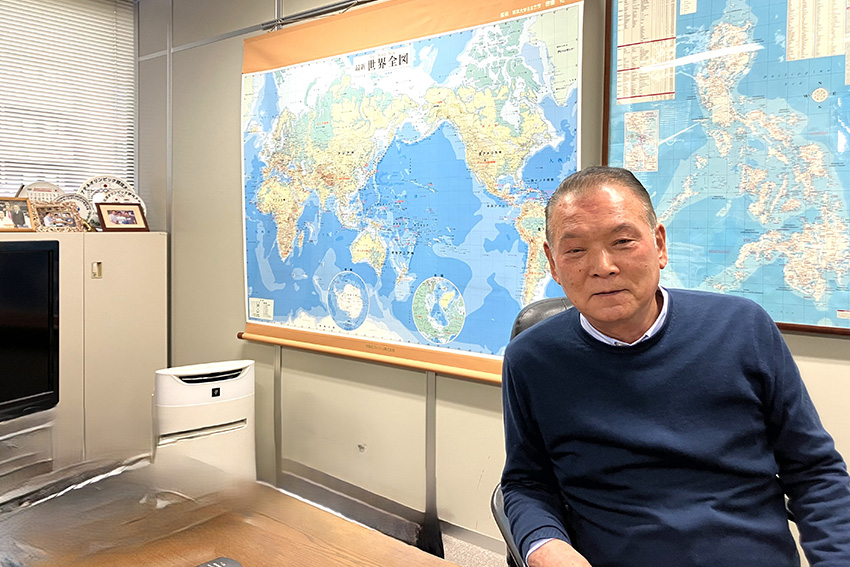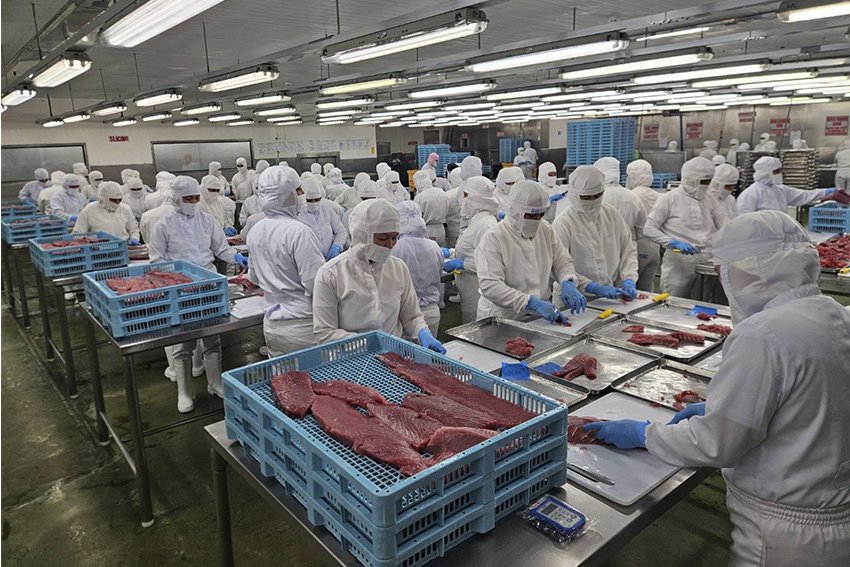Pesca Rich is commited to excellence, ensures that it provides customers with fresh and responsibly harvested seafood that tastes great.

Food-related exports from Japan have reached record highs for 11 consecutive years and are expected to hit 1.45 trillion yen by 2023. Globally, the popularity of Japanese cuisine is evident, with the number of Japanese restaurants abroad tripling over the past decade—from 55,000 in 2013 to approximately 200,000 today. What do you see as the key drivers behind the continued rise in Japanese food exports and the growing global popularity of Japanese cuisine?
The biggest milestone for Japanese food was its recognition as a UNESCO Intangible Cultural Heritage in 2013. This global acknowledgment highlighted Japanese cuisine's exceptional qualities, including its taste, nutritional balance, health benefits, and visual appeal. These factors, along with the weak yen, have significantly boosted the popularity of Japanese food worldwide.
You mentioned there are 200,000 Japanese restaurants globally, but while I don’t have the exact figures, I believe the number has already surpassed that milestone.
In response to the growth in Japanese food exports, the government has adopted more globally focused and proactive policies, such as establishing the Japan Food Overseas Promotion Center, to further drive these numbers. Japan is now aiming to increase food exports to 5 trillion yen by the end of the decade. Do you believe this goal is achievable within the given time frame? If so, what steps or initiatives do you think are necessary to make this ambitious target a reality?
If the current average annual growth rate continues, achieving 5 trillion yen in food exports will soon become attainable. However, rather than solely focusing on numerical targets, it is crucial for the Japanese government and businesses to collaborate in promoting the unique appeal of Japanese food. This includes emphasizing its safety, security, health benefits, and sustainability.
By effectively communicating these qualities to the world, I am confident that demand for Japanese food will continue to grow. Moreover, offering a healthy and enriched dietary lifestyle aligns with the needs and preferences of people globally, further driving this expansion.
How do you think Japanese food is perceived in Western countries compared to how it is viewed in Japan? Additionally, why do you think Japanese food tends to be more expensive overseas?
In other countries, Japanese food is often regarded as delicate, beautiful, delicious, and healthy. However, prices are typically much higher than in Japan. This is because offering Japanese food in the same way as it is presented in Japan comes with significant challenges. Raw materials are often limited, and imported ingredients must be used. Additionally, the lack of established cold chain infrastructure in many countries means there are limited procurement routes, which further drives up costs.
In contrast, Japan faces an oversupply of food, leading to relentless price competition. There is a prevailing mindset that equates good food with cheap food. In both cases, finding a balance and achieving reasonable pricing is essential for sustainability and long-term success.
One of the core aspects of your tuna business is the catch, centered around your factory in the Philippines, widely regarded as the tuna capital of the world. Your local team employs a meticulous processing system, including the careful selection of single-fish yellowfin tuna, strict quality control with x-ray detection, precise processing using traditional Japanese knife techniques, and quick freezing to ensure optimal freshness and quality. What advantages does your Philippine factory offer over your competitors, and how do you ensure the quality and freshness of tuna during processing for export to other countries?
The tuna landed at General Santos in the Philippines is primarily hand-lined tuna. This method ensures the tuna is caught alive, resulting in exceptional freshness. Additionally, hand-line fishing is a more sustainable practice compared to purse seine or long-line fishing, as it avoids overfishing and helps protect marine resources.
Once landed, the tuna is carefully sorted by skilled staff at the fish port. Depending on the destination, it is either transported fresh by air or disassembled, processed, and flash-frozen at our factory. Throughout the entire process, we maintain the appropriate temperature range for each stage to ensure optimal freshness and quality during transport to its final destination.

In recent years, overfishing and significant population declines have raised concerns about the sustainability of eel consumption. The Japanese eel, in particular, is now listed as an endangered species. While aquaculture offers a potential solution to mitigate these declines, breeding eels in captivity remains a major challenge. Pesca Rich is actively working in this area with an integrated production system that includes your own eel farm in Guangdong Province, China. Could you tell us more about how your farm operates? How does it address sustainability concerns, particularly in overcoming the challenges of breeding Japonica and other eel species in captivity?
The IUCN listed the two-spotted eel (Anguilla Japonica) as a Category IB endangered species in June 2014, while the Anguilla rostrata species is similarly listed under Class IB. The European eel (Anguilla Anguilla) is classified as Class IA, and Pesca Rich does not handle this species, nor are there plans to do so.
For Anguilla Japonica, only properly harvested juvenile eels—sourced under strict resource management agreements between Japan, China, South Korea, and Taiwan—are used for farming. Similarly, strict controls are in place for Anguilla rostrata, ensuring that no illegal, unreported, or unregulated (IUU) fry are imported.
At our farms, we maintain rigorous standards for feed and development, raising eels in near-natural conditions without the use of pesticides, antibiotics, or other medications. Eels are carefully cultivated to ensure health and quality before being transported to our factory for processing.
Currently, we are making every possible effort to ensure sustainable practices in eel farming, processing, and sales to secure the future of this industry while addressing environmental and resource management concerns.

As part of your tempura business, you operate a production facility in China that focuses on vegetable tempura and another facility in Indonesia that specializes in shrimp tempura. Given that Indonesia is renowned as one of the leading shrimp-producing countries, do you utilize Japanese proprietary technology in your production processes in both China and Indonesia to ensure the highest quality products?
What sets our tempura apart is its texture. Tempura needs to be crispy, and when placed on soba or udon noodles, it should crumble and blend seamlessly with the soup. To achieve this, we have developed a unique method where the tempura is half-cooked in the factory and then deep-fried again in Japan just before being served.
Typically, frozen foods tend to be sticky, but for tempura, maintaining crispiness and freshness is crucial. That’s why we’ve created a specialized process that ensures a distinct, high-quality texture, making our tempura truly unique.
Partnerships are a vital aspect of your business, with over 500 partners worldwide, including fisheries that follow sustainable fishing practices and major supermarkets in the U.S. and Europe. Are you looking to expand your international partnership network further? If so, which types of partnerships and which countries would be the most valuable to your company’s growth?
The U.S. market is expected to continue growing, especially since it was the first country to embrace Japanese food and culture. Additionally, the U.S. population is steadily increasing, providing further opportunities for expansion.
At the same time, we view Europe as having the greatest potential for growth, followed closely by Southeast Asia. If China lifts its import ban, we anticipate significant business opportunities in that market as well.
Why do you believe your company is uniquely positioned to capitalize on these opportunities abroad? What specific strategies or steps do you plan to implement over the next few years to expand your global presence?
We are the global choice because we are a market leader and pioneer in our industry. Over the years, we have built a strong network of partnerships and relationships with key stakeholders. Additionally, we offer a wide range of unique products that leverage advanced freezing and processing technologies to ensure optimal freshness.
Our approach is highly customer-focused—we always strive to understand how our products are being used, the situations in which they’re applied, the challenges customers face, and areas where we can improve. Based on this feedback, we make tailored suggestions to meet their needs effectively.
Looking ahead, we plan to continue utilizing our overseas bases to develop products while staying closely attuned to the voices of our local customers, ensuring we deliver innovative solutions that align with their specific preferences and requirements.
You mentioned your advanced refrigeration technology. Could you elaborate on the types of refrigeration technology you use and how it is specifically applied to different species of fish and various cuts?
First, we prioritize the skillful selection of the best raw materials. Once we’ve sourced the highest-quality fish, we use our unique refrigeration technology to preserve their freshness, taste, and texture.
This advanced freezing technology, combined with our precise processing techniques, enables us to deliver fresher tuna and other seafood to your table, ensuring the highest quality for our customers.
Our technology is proprietary and does not have a specific name. It’s important to note that while CO (carbon monoxide) treatment can preserve the red color of tuna, it does not maintain its freshness.
In the U.S. and some other countries, CO treatment is permitted due to its similarity to traditional smoking processes, which are culturally accepted. However, in Europe, this process is banned, reflecting differences in regulatory standards and consumer preferences.
If we were to interview you again in 2030, on your company’s 25th anniversary, what accomplishments would you like to have achieved by then? Do you have any personal goals or ambitions you hope to fulfill during this time?
As president, I understand the importance of having a clear vision for the future. In Japan, the population is declining, and the domestic market is shrinking. However, we see significant opportunities in new markets overseas.
Natural resources, including fish, are becoming increasingly difficult to secure, and rising prices present additional challenges. Our focus is on maintaining affordability while continuing to provide safe and reliable food resources.
To achieve growth, it’s essential to strike the right balance between pricing and market needs. Additionally, maintaining a pioneering spirit and constantly exploring new opportunities are critical to ensuring our long-term success.
For more information, please visit their website at: https://pescarich.com/
0 COMMENTS